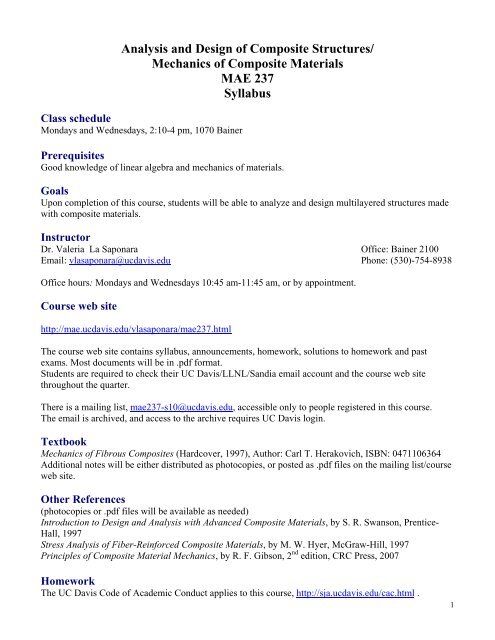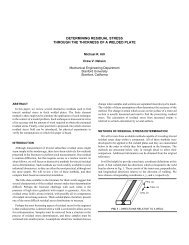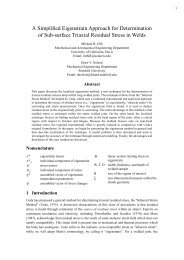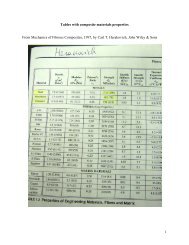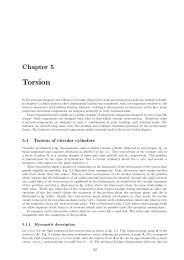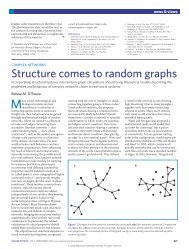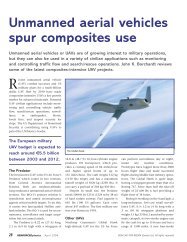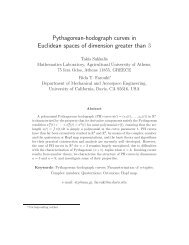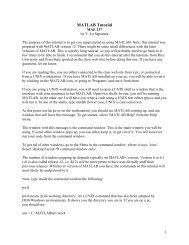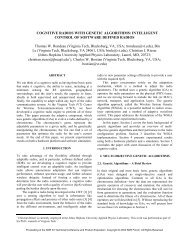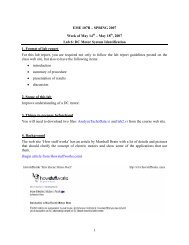Analysis and Design of Composite Structures ... - UC Davis
Analysis and Design of Composite Structures ... - UC Davis
Analysis and Design of Composite Structures ... - UC Davis
You also want an ePaper? Increase the reach of your titles
YUMPU automatically turns print PDFs into web optimized ePapers that Google loves.
<strong>Analysis</strong> <strong>and</strong> <strong>Design</strong> <strong>of</strong> <strong>Composite</strong> <strong>Structures</strong>/<br />
Mechanics <strong>of</strong> <strong>Composite</strong> Materials<br />
MAE 237<br />
Syllabus<br />
Class schedule<br />
Mondays <strong>and</strong> Wednesdays, 2:10-4 pm, 1070 Bainer<br />
Prerequisites<br />
Good knowledge <strong>of</strong> linear algebra <strong>and</strong> mechanics <strong>of</strong> materials.<br />
Goals<br />
Upon completion <strong>of</strong> this course, students will be able to analyze <strong>and</strong> design multilayered structures made<br />
with composite materials.<br />
Instructor<br />
Dr. Valeria La Saponara Office: Bainer 2100<br />
Email: vlasaponara@ucdavis.edu Phone: (530)-754-8938<br />
Office hours: Mondays <strong>and</strong> Wednesdays 10:45 am-11:45 am, or by appointment.<br />
Course web site<br />
http://mae.ucdavis.edu/vlasaponara/mae237.html<br />
The course web site contains syllabus, announcements, homework, solutions to homework <strong>and</strong> past<br />
exams. Most documents will be in .pdf format.<br />
Students are required to check their <strong>UC</strong> <strong>Davis</strong>/LLNL/S<strong>and</strong>ia email account <strong>and</strong> the course web site<br />
throughout the quarter.<br />
There is a mailing list, mae237-s10@ucdavis.edu, accessible only to people registered in this course.<br />
The email is archived, <strong>and</strong> access to the archive requires <strong>UC</strong> <strong>Davis</strong> login.<br />
Textbook<br />
Mechanics <strong>of</strong> Fibrous <strong>Composite</strong>s (Hardcover, 1997), Author: Carl T. Herakovich, ISBN: 0471106364<br />
Additional notes will be either distributed as photocopies, or posted as .pdf files on the mailing list/course<br />
web site.<br />
Other References<br />
(photocopies or .pdf files will be available as needed)<br />
Introduction to <strong>Design</strong> <strong>and</strong> <strong>Analysis</strong> with Advanced <strong>Composite</strong> Materials, by S. R. Swanson, Prentice-<br />
Hall, 1997<br />
Stress <strong>Analysis</strong> <strong>of</strong> Fiber-Reinforced <strong>Composite</strong> Materials, by M. W. Hyer, McGraw-Hill, 1997<br />
Principles <strong>of</strong> <strong>Composite</strong> Material Mechanics, by R. F. Gibson, 2 nd edition, CRC Press, 2007<br />
Homework<br />
The <strong>UC</strong> <strong>Davis</strong> Code <strong>of</strong> Academic Conduct applies to this course, http://sja.ucdavis.edu/cac.html .<br />
1
Students are encouraged to discuss with each other about the homework, but the final product needs to be<br />
only the work <strong>of</strong> the person who has the name on it. Copy-<strong>and</strong>-paste <strong>and</strong> plagiarism will not be<br />
tolerated.<br />
Late homework will not be accepted, unless there is a documented emergency, discussed with the<br />
instructor before the deadline.<br />
Homework in electronic form will only be accepted if sent from virus-free <strong>UC</strong> <strong>Davis</strong> or LLNL/S<strong>and</strong>ia<br />
accounts. The size <strong>of</strong> the overall attachments must be less than 5 MB. At (electronic) submission, you<br />
need to carbon-copy yourself.<br />
Homework codes<br />
Homework needs to be submitted as one single document, in Word or .pdf format. The only exception<br />
to the one-file policy is for Excel spreadsheets, which must be e-mailed separately. Source codes must be<br />
included in the document itself, with the exception <strong>of</strong> Excel spreadsheets, as discussed above.<br />
Acceptable ‘languages’ are MATLAB, FORTRAN <strong>and</strong> R. Source codes must be commented <strong>and</strong> include<br />
units for input <strong>and</strong> output.<br />
Academic holidays<br />
Monday May 31 st , Memorial Day<br />
Grading, exams<br />
The final grade for the course will be based on the following:<br />
Homework 20%<br />
Midterm exam on (tentative) Wednesday May 12 th , 2:10-4 pm 40%<br />
Final exam on Monday June 7 th , 3:30-5:30 pm 40%<br />
Total 100%<br />
The exams will be open notes/open books. Make-up exams will only be given for documented<br />
emergencies.<br />
Course topics<br />
1.Advanced <strong>Composite</strong> Materials <strong>and</strong> their Applications<br />
Introduction<br />
Fibers<br />
Matrix materials<br />
Material forms <strong>and</strong> fabrication methods<br />
Current applications<br />
2.Concepts <strong>of</strong> solid mechanics<br />
Tensors<br />
Stress <strong>and</strong> strain<br />
Plane stress <strong>and</strong> plane strain<br />
Strain energy density<br />
Generalized Hooke's Law<br />
Material symmetry<br />
Engineering constants<br />
2
Coordinate transformations<br />
Thermal effects<br />
Moisture effects<br />
Chemical aging, flammability<br />
3.Concepts <strong>of</strong> Micromechanics<br />
Effective properties<br />
Survey <strong>and</strong> model comparison from strength <strong>of</strong> materials approximations, continuum mechanics<br />
approaches<br />
4.Stress-strain relationship for an orthotropic lamina<br />
Orthotropic properties in plane stress<br />
5.Laminate analysis<br />
Deformation due to extension/shear <strong>and</strong> bending/torsion<br />
A, B, D matrices<br />
Hygrothermal behavior<br />
Special laminates<br />
Average stress-strain properties<br />
6.Concepts <strong>of</strong> failure <strong>of</strong> laminates<br />
Tensile failure <strong>of</strong> fiber composites<br />
Compressive failure <strong>of</strong> fiber composites<br />
Effect <strong>of</strong> multiaxial stresses (failure criteria by Tsai-Wu, Hashin, etc.)<br />
Edge effects<br />
7. Laminated beams <strong>and</strong> shafts<br />
Effective stiffness <strong>of</strong> beams<br />
Effective stiffness <strong>of</strong> shafts<br />
Classroom Etiquette<br />
This section has been prepared using the material available on the web site <strong>of</strong> <strong>UC</strong> <strong>Davis</strong> Student Judicial<br />
Affairs, www. sja.ucdavis.edu/<br />
The following expectations are to enhance the students’ ability to learn in this class, to avoid disruptions<br />
<strong>and</strong> distractions, <strong>and</strong> to improve the quality <strong>of</strong> the classroom experience. Repeated failure to meet these<br />
expectations may result in a lower grade for the course. Student Judicial Affairs gives the instructor the<br />
authority <strong>and</strong> discretion to set rules that foster student learning, <strong>and</strong> to determine what constitutes<br />
disruptive behavior.<br />
Quoted from www. sja.ucdavis.edu:<br />
3
(end quote)<br />
4


